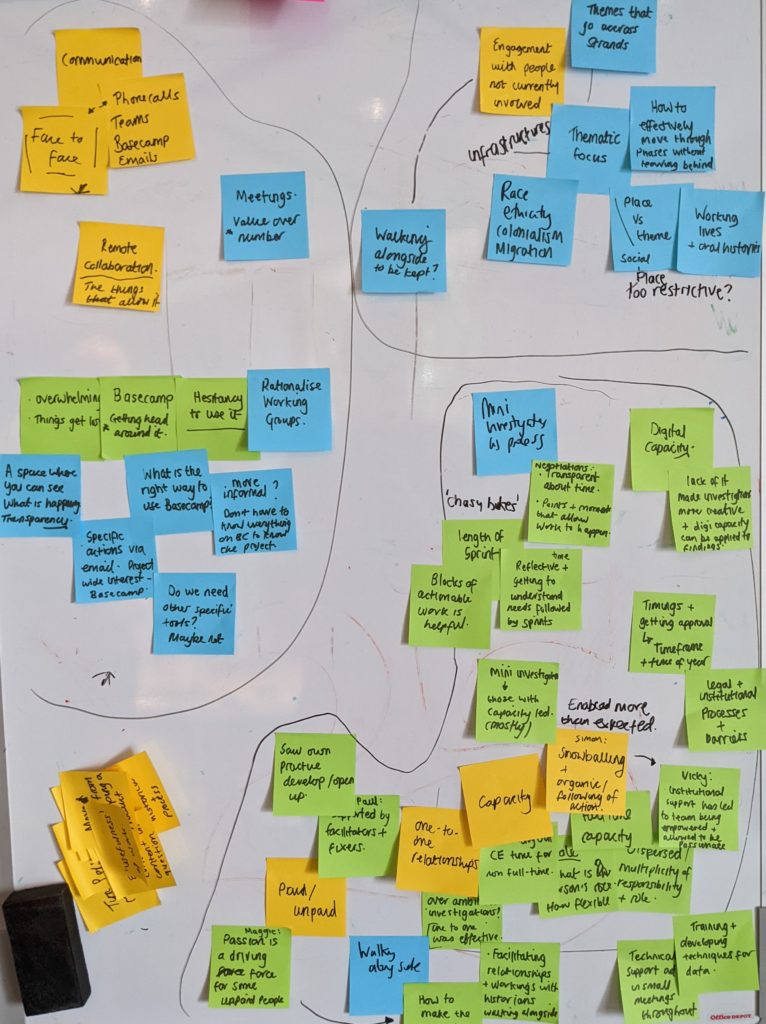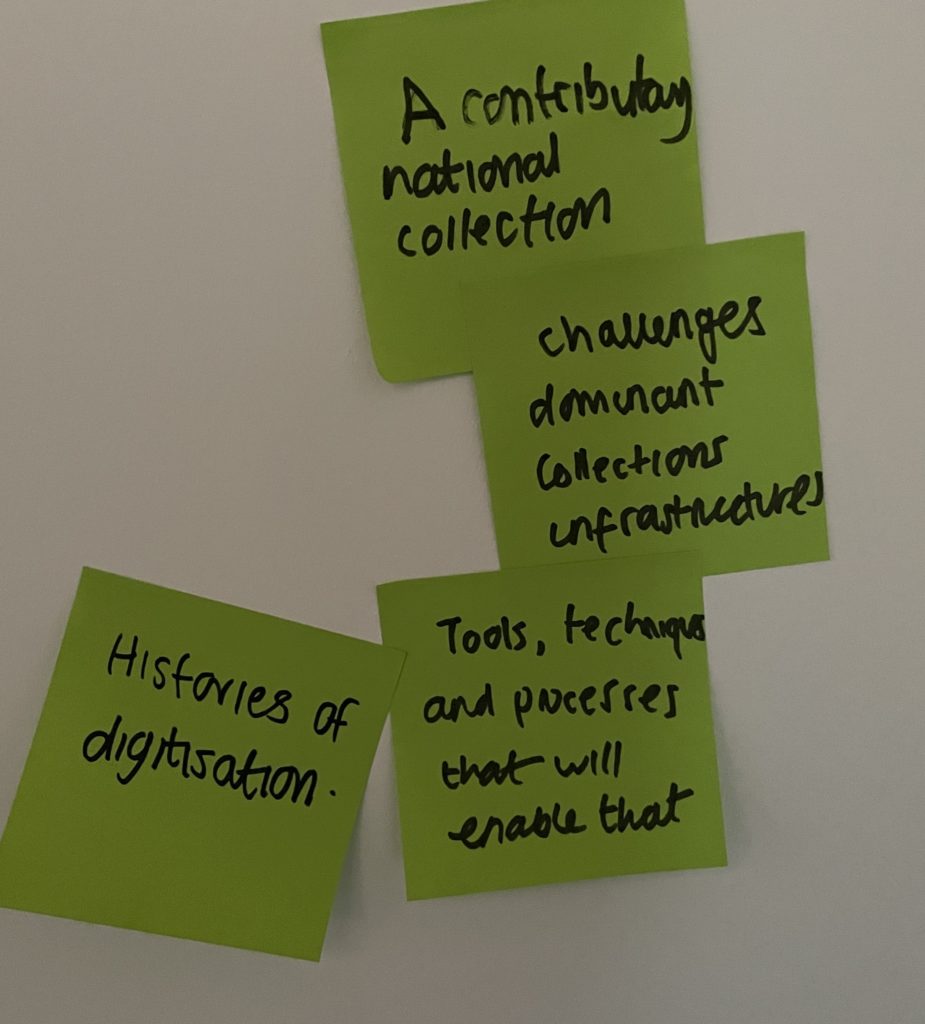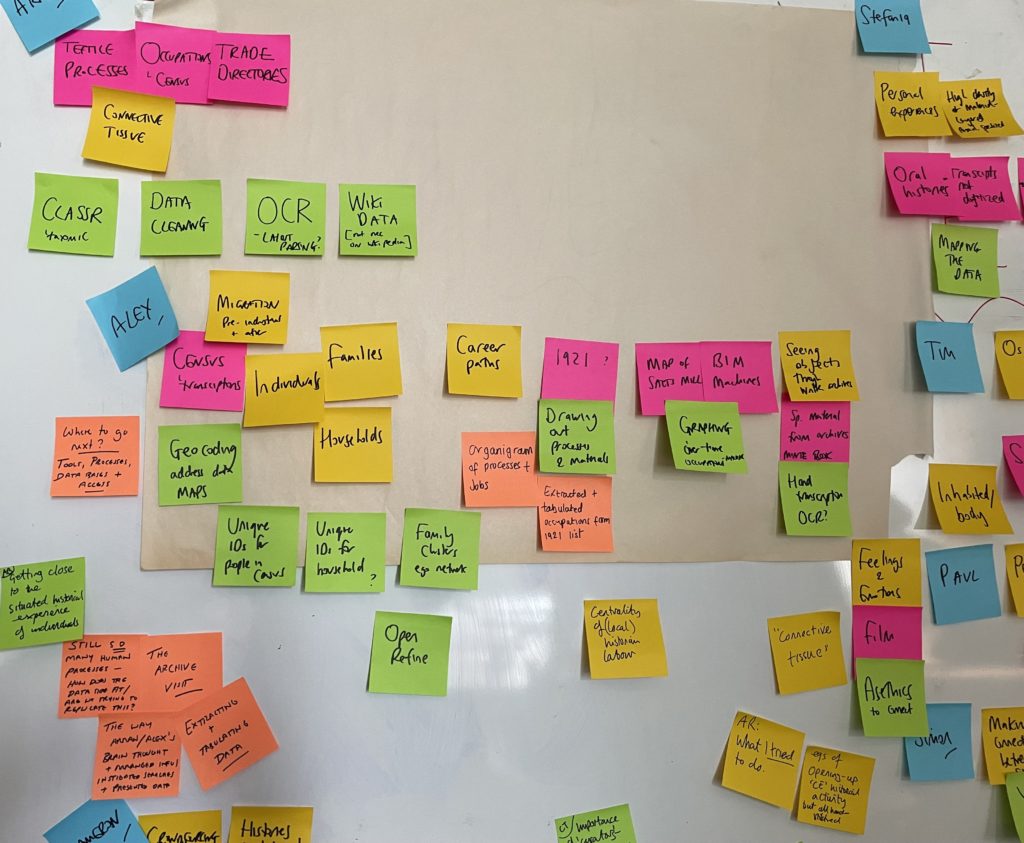Written by Helen Graham and Arran Rees
On 27th July we met to reflect on the mini-inquiries that had developed after the Leeds workshop, on the textiles pilot more generally, and to begin planning forward for the next phase of the textiles strand that will expand to cover Lancashire and the cotton industry too.
The way in which the mini-inquiries were co-produced is described in one of our previous blog posts. For this phase of the project, we decided to concentrate on Salts Mill (Saltaire) and Listers Mill (Manningham). The inquiries were run over a period of four weeks and helped produce a lot of useful insights for the project. This workshop marked the end of our first cycle of action research, consolidating the textiles pilot investigations we started March (read our blog on the Congruence Engine opening conference for more information on how that came about).

The mini-inquiries we discussed in the first part of the workshop were:
- Connecting People, Occupations, and Machines
- How effective are oral histories in connecting collections?
- Aesthetic, aural, and visual approaches to connecting heritage
- Connecting photographs and people using facial recognition
- Connecting collections, stories, and resources through YARN
- The Saltaire community, 1851-1911. Modelling families, spaces, sociabilities and occupations
A number of these will be the subjects of longer blog posts soon!
Doing our best to maintain our reflective mode and sense of togetherness whilst operating in a hybrid meeting, we spent the best part of a day reflecting on the mini-investigations and the work that had preceded it as part of the textiles strand. The room we were in became somewhat of a den of post-it notes, mapping the reflections, connections and clusters of concern.
A selection of images from the workshop. Post-it notes from the mini-investigation presentations and the facilitated group reflections. Photographs by Arran Rees and Helen Graham.
- Considering ‘to National Collection’ as a verb;
- The mini-inquiry processes worked as a research method;
- Our distributed activity is part of learning how to create a National Collection;
- Our work requires small scale ‘handstitched’ research and big data approaches to happen in conversation with each other.
What does considering the National Collection as A verb do?
We’ve said from the start that we’re not building a Congruence Engine but that ‘we are Congruence Engine’. Yet – as a project team – we’ve definitely experienced times when we slipped backwards and forwards between a focus on process and one that has seemed closer to producing a product.
The workshop discussion clarified and gave new language to the idea that a national collection doesn’t necessarily exist on its own; it is in the active formation of connections that a national collection emerges. Our approach is about designing processes and supporting people to contribute to the creation of a national collection through the ways in which they make connections between collections.
The mini-inquiries approach worked – but are affected by ‘material conditions’
As Arran and Tim reflected on in the blog on the Leeds workshop, we were surprised by the way the mini-inquiries emerged. Initially we had anticipated them being historical – or digital – led and supported by facilitators who would ‘walk alongside’ the initiating researchers, assisting and recording their inquiries. What happened instead was that core the Congruence Engine questions that emerged in the Leeds workshop – precisely focused on how to make connections between collections – came mainly to be led by the people who had significant amounts of paid time on the project, the research fellows mainly. In many ways this makes sense; those with the most amount of time took the lead. There was also a sense that working across collections of various kinds may be a novel approach for many traditional historical researchers, and that these trial demonstrations will inspire the participants in the next phases to take on their own mini-inquiries.
In this short time frame of four weeks, we had momentum and a real sense of shared purpose. The facilitators were able to flexibly draw people into their inquiries as they unfolded, and this enabled different types and intensities of involvement from both our volunteer partners from Saltaire and the technologists in the team.
There was one project example – facilitated by Alex Butterworth in collaboration with Colin Coates and Caroline Perry – where the ‘walking alongside’ approach was used somewhat as we had originally intended, and it showed that this mode of working still has rich potential.
Distributed activity: Paying attention to how we are working together as part of learning about ‘to National Collection’ as a verb
Congruence Engine is constructed as a distributed project, with 50+ team members spread across the country. What we have noticed is that how we work together is not just a practical or managerial project concern but a core research concern, so we have decided to elevate our ‘how we work together’ questions.
Our shared digital space (the project Basecamp) has worked in some ways, but our reflections in the workshop highlighted some issues: mainly that the proliferation of sections and postings on Basecamp can feel overwhelming and that the documentation that is being produced isn’t easy to find (though it is there). Drawing on Asa Calow’s reading around distributed and hybrid work, we discussed the importance of documentation as part of the project – but also potentially as a key aspect of ‘to national collection’ as a verb too.
We noted that while documentation is a facet of almost all research and professional practices, it has different cultural connotations (sometimes it feels imposed from the outside as part of governance; sometime more as a generous community-built practice). We decided to experiment with how to cultivate a positive and pleasurable culture around documentation.
Handstitched v machine learning approaches (it’s not an opposition, it’s a loop)
In some ways the mini-inquiries could be considered ‘handstitched’ – but they also showed and created the potential for more advanced computational methods, scaling up towards using bigger sets of data and more machine learning as we move, iteratively, through the project. For us, handstitched and machine learning approaches do not exist as polar opposites – we are seeking to actively move between the two to inform our next steps. For example, the handwritten handbooks being looked at by Alex and Caroline offer some potential for handwriting recognition, optical character recognition (OCR) and Natural Language Processing work, but we only know that because of the handstitched work that Caroline has done with them already.
Stefania’s work was also helpful in showing the limitations of current Named Entity Recognition (NER) tools. Stefania manually extracted entities from the oral histories she was working with and then Jamie Unwin compared them with those extracted using NER tools. Concepts like occupations, trades, techniques and skills, but also relationships with social issues, emotions and feelings, were completely missed by existing tools. This handstitched approach was helpful in informing how NER tools would have to be trained if we were to use them, or how we might opt for other approaches like fuzzy matching instead.
What to take forward
The final activity of the workshop was to identify and prioritise ideas for next steps. We’ll be running another workshop in Manchester this autumn. Like the Leeds workshop, we’ll be meeting to help co-produce our inquiries for the next group of mini and walking alongside investigations.
2 comments on “Reflecting on the Textiles Pilot”
Comments are closed.




I have found the Congruence experience underwhelming.
As a Saltaire researcher for over 10 years and a contributor to both the village website and the Saltaire archives, I was asked if I would participate in a textile project. I agreed and I look forward to engaging with people.
Given that I live in Australia I could not attend the 20-21 June in person, but I did sit in through zoom for the first hour.
Out of this I had a number of zoom chats with Alex Butterworth and I handed a few files over.
I also had an email exchange with Stefanie Zardini and an email exchange with Arran Rees.
I also attended a reflection workshop by zoom on 27 July.
That’s it. That’s all I have done. I have had no meaningful contact with anyone since August.
I must make the point this is not a criticism of the three individuals I have named. Quite the opposite in fact. I found Alex in particular an engaging person with bright ideas.
This is simply my view of my congruence experience.
Hi Colin,
Thank you so much for your post and for sharing your experience of Congruence Engine.
We’ve appreciated so much your involvement in the project and your willingness to share your wealth of knowledge on Saltaire, as well as the data you have created through your research.
We recognize that when we started the project we were unable to be completely clear about the nature of Congruence Engine – and therefore about what your involvement might be. We needed to use the Textiles Pilot to figure out our methods and how we needed to work to address our project’s research questions. This was a bit bumpy and we are very sorry that you experienced a bit of this bumpiness.
It is true, also, that the timezones and distance haven’t been our friend in terms of working together!
We have learnt a lot now about what we are as a project and what we need to do in this second phase of textiles work and beyond. We have ideas about we might work with you – and we know part of this needs to be a very clear and upfront conversation about what you want and are expecting and what we can offer.
With best wishes – and with another thank you for your involvement in the project so far,
Alex, Helen and Tim